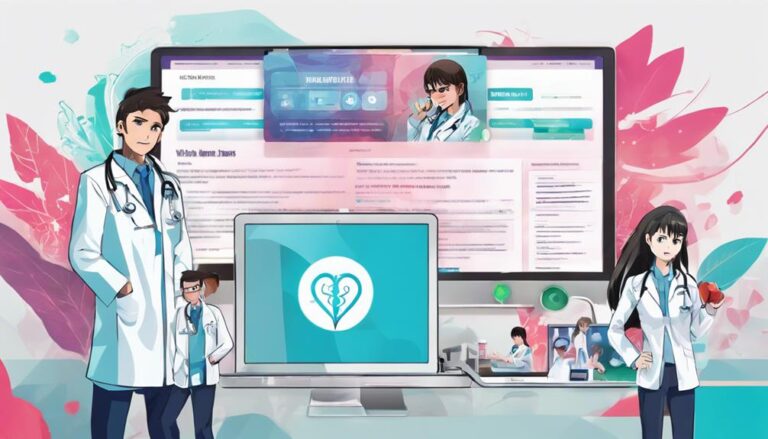Content Marketing for Healthcare: Building Trust and Generating Leads
In the healthcare industry, content marketing is essential. Educate patients to build trust and generate leads. Tailor information to resonate with different demographics. Engage with compelling storytelling and patient experiences. Explore various content formats like video and infographics for broader reach. Maintain a consistent voice for brand recognition and trust. Optimize content with SEO strategies for lead generation success. By implementing these strategies, you can establish trust, engage patients, and drive leads effectively. Further insights await on how to maximize your content marketing potential in healthcare.
Key Takeaways
- Consistent messaging builds trust and brand recognition.
- Valuable content engages the healthcare audience effectively.
- Lead nurturing strategies guide potential leads strategically.
- SEO optimization boosts online visibility for healthcare content.
- Strong call to action prompts encourage lead generation.
Importance of Content Marketing in Healthcare
In healthcare, content marketing plays an essential role in educating patients and building trust with potential clients. By targeting patients with valuable educational resources, healthcare providers can empower individuals to make informed decisions about their health. Providing easy access to reliable information through blogs, videos, infographics, and social media platforms helps patients better understand their conditions, treatment options, and preventive measures.
Educational resources create a sense of transparency and credibility, establishing healthcare providers as trustworthy sources of information. When patients feel knowledgeable and supported, they’re more likely to engage with healthcare services and follow treatment plans effectively. Additionally, content marketing allows for personalized communication tailored to address specific patient needs and concerns, fostering a sense of connection and empathy.
Understanding Your Target Audience
To better connect with your audience in healthcare content marketing, understanding their needs and preferences is essential for creating impactful and relevant materials. By delving into patient demographics, you can gain valuable insights into the characteristics of your target audience, such as age, gender, location, and socioeconomic background. This data can help tailor your content to resonate with specific groups within your patient population. Understanding care preferences is equally vital. Some patients may prefer detailed medical information, while others might respond better to simplified explanations or visual aids. By recognizing these preferences, you can craft content that speaks directly to the needs of your audience, fostering a deeper connection and trust.
Analyzing patient demographics and care preferences allows you to create content that addresses the unique concerns and interests of your target audience. This personalized approach demonstrates that you understand and value your patients, ultimately leading to more effective communication and engagement.
Creating Valuable and Informative Content
Understanding your audience’s demographics and care preferences lays the foundation for creating valuable and informative healthcare content that resonates with their unique needs and interests. By delving into the data, you can shape your content strategy to deliver engaging storytelling that captivates your audience. Consider crafting narratives that highlight real-life patient experiences or success stories to make the information more relatable and impactful.
In addition to storytelling, educational resources play a vital role in providing valuable content to your audience. By offering in-depth articles, infographics, or videos that explain complex medical topics in an accessible way, you can empower your audience with knowledge that helps them make informed decisions about their health.
Leveraging Different Content Formats
When diversifying your content formats, consider tailoring each piece to cater to the varied preferences and learning styles of your audience. Video marketing can be a powerful tool in engaging with your healthcare audience. People often find videos more engaging and easier to digest than written content. Create informative videos that address common healthcare concerns, showcase patient testimonials, or provide insights into medical procedures to connect with your audience on a deeper level.
Infographic creation is another effective way to leverage different content formats. Infographics can simplify complex healthcare information, making it easier for your audience to understand and retain key details. Consider creating infographics that highlight important statistics, explain medical processes visually, or compare different treatment options. These visually appealing assets can be shared across various platforms, increasing your reach and engagement.
Building Trust With Consistent Messaging
Consider how your audience perceives your healthcare content; every message you put out shapes their trust in your brand, making consistent messaging a cornerstone of building lasting relationships. To establish credibility and foster relationships effectively, it’s important to maintain a consistent tone, style, and quality across all your content channels. This ensures that your audience recognizes and trusts your brand identity.
| Consistent Messaging Tips | Description | Benefits |
|---|---|---|
| Maintain Brand Voice | Keep your tone and style uniform across all content to create a recognizable brand identity | Builds brand recognition and loyalty |
| Use Clear and Concise Language | Communicate information effectively and avoid confusion | Enhances audience understanding and trust |
| Provide Value in Every Message | Make sure that each piece of content offers value to your audience, whether through information, entertainment, or inspiration | Increases audience engagement and loyalty |
Optimizing Content for Lead Generation
To optimize your healthcare content for lead generation, focus on creating valuable and engaging material that resonates with your target audience. Implement lead nurturing strategies to guide potential leads through the conversion funnel effectively. By providing informative and relevant content, you can establish trust and credibility, making it more likely for visitors to become leads.
Utilize SEO optimization techniques to improve the visibility of your content online. Conduct keyword research to understand what your audience is searching for and incorporate those keywords naturally into your content. This will help drive organic traffic to your website and attract qualified leads.
Texas residents seeking to enhance their healthcare business visibility online can benefit from partnering with an Austin medical SEO company that understands the local market. This strategic collaboration can help attract more qualified leads through targeted search optimization.
Incorporate strong call to action strategies in your content to encourage visitors to take the next step. Whether it’s signing up for a newsletter, scheduling a consultation, or downloading a resource, clear and compelling calls to action can have a significant impact on lead generation.
Conclusion
You’ve learned how content marketing can help healthcare providers like you build trust and generate leads. By understanding your audience, creating valuable content, and optimizing for lead generation, you’re on the right track.
Remember, content is like a compass guiding patients to your practice. Keep providing informative and engaging material to lead them on a journey of trust and connection.
Keep up the good work!







